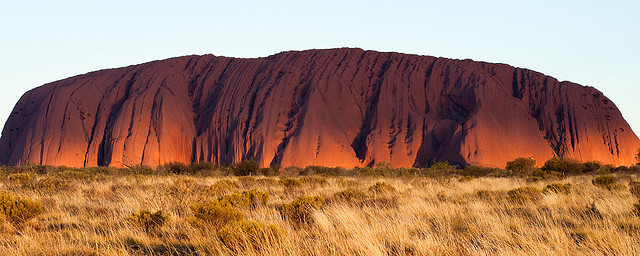Weather in Australia
 Australia is the world’s driest inhabited continent. A huge landmass in the southern hemisphere, the country offers a variety of climatic zones, from the tropical state of Queensland to the desert of the central area and the temperate south-east (New South Wales and Victoria).
Australia is the world’s driest inhabited continent. A huge landmass in the southern hemisphere, the country offers a variety of climatic zones, from the tropical state of Queensland to the desert of the central area and the temperate south-east (New South Wales and Victoria).
Being in the southern hemisphere the seasons in Australia are the reverse of those north of the Equator. Summer in Australia runs roughly through December, January and February; Autumn in Australia is March, April and May; Australia’s Winter traverses June, July and August; and Spring in Australia covers September, October and November.
Peak summer holiday time in Australia thus covers the Christmas season, which is also the country’s end of year break, with scholars and students enjoying their long summer vacation.
Summers in Australia are extremely hot overall. In the northern tropical regions high temperatures are exacerbated by high humidity and monsoon rainfall, while in the desert areas and Western Australia temperatures soar to well above 40°C (104°F).
To best anticipate what weather to expect on holiday in Australia let us examine each region independently.
The tropical north
The tropical area of Australia covers 42% of the country’s landmass, from the red desert in the centre of the country to the rich rainforests along the northern coast, especially the northern reaches of the state of Queensland (above Rockhampton) and the holiday playground of the magnificent Great Barrier Reef. The city of Darwin, capital of the Northern Territory on the Timor Sea, shares in this tropical climate. All these areas experience only two seasons – wet and dry – and are prone to cyclones and flooding. The “wet” monsoon season strikes typically in summer between October and April when moist north-westerly winds bring humid, showery conditions and thunderstorms, while winters are usually dry with warm, sunny conditions. Throughout the year temperatures remain consistently high.
Central Australia
The driest and hottest region of Australia is the heart of the continent, embracing the inland areas of Western Australia, the southern parts of the Northern Territory, most of South Australia, the western regions of Queensland and New South Wales, and the north-western parts of Victoria. This is the area commonly referred to by tourists as the “Outback”. Searingly hot in summer during the day, with very cold nights, and mild with little variation between night and day during the winter months, these arid desert areas are almost constantly in a state of drought, but have their own haunting beauty.
The southeast of Australia
The southeast of Australia – along the coast, through Victoria, New South Wales (including Sydney), Tasmania, and into the southern parts of Queensland – enjoys a temperate climate with changeable weather and more distinguishable seasonal variations than are the case in the rest of the country. Summers are pleasant with temperatures averaging around 30°C (86°F), while winters are cool with the mercury hovering at around 15°C (59°F). Summers are dry, winters wet and windy, with some pleasant shoulder seasons marking spring and autumn inbetween. Snow falls in winter along the Great Dividing Range that cuts through New South Wales and Victoria.
Weather warnings
Many areas of Australia are prone to devastating bush-fires, particularly during the dry summers when the Eucalyptus trees and grasses in the countryside turn into a tinder-box, egged on by high winds. It is advisable to wise up on bushfire prevention methods if visiting the south-eastern parts of the country during the summer. The coasts of Western Australia, the Northern Territory and Queensland are at risk of cyclones during the months of November, December, January, February, March and April. Around six cyclones occur on average each year in these areas, of varying degrees of intensity.
What’s the best time to visit Australia?
Although much depends on the purpose of your visit, and where exactly in Australia you plan to go, the best time to visit most places in Australia is from late summer (March) through Autumn (April and May), or in spring (August, September and October). At all costs avoid the northern tropical areas during the wet season (November, December, January, February and March) when Queensland, Darwin and the Great Barrier Reef are swept with monsoon thunderstorms, high winds and cyclones, along with sweltering heat and humidity. All of Australia is extremely hot and busy during December and January when locals have their summer break, meaning accommodation near beaches is at a premium and prices soar.
What to pack for a holiday in Australia
It’s best to check the current weather conditions to get an idea of what to pack; however, here are a few general suggestions. Take quick drying clothing and materials because the humidity makes it impossible to dry out thick woolly materials after a wet day. Strong amphibian walking shoes or boots are ideal, sandals are essential and trainers are good for the city. Bring tons of sunscreen, a hat (broad rimmed preferably) and sunglasses. Changes of swimwear is useful for the coast and take a sarong or light covering as well; long sleeved shirts and trousers are good for covering as well, especially during treks, as they provide protection from the sun and mosquito bites– so bring plenty of insect repellent. Finally, take something smart for a fancy city restaurant or nightclub.
Related Content:
- Login to post comments

